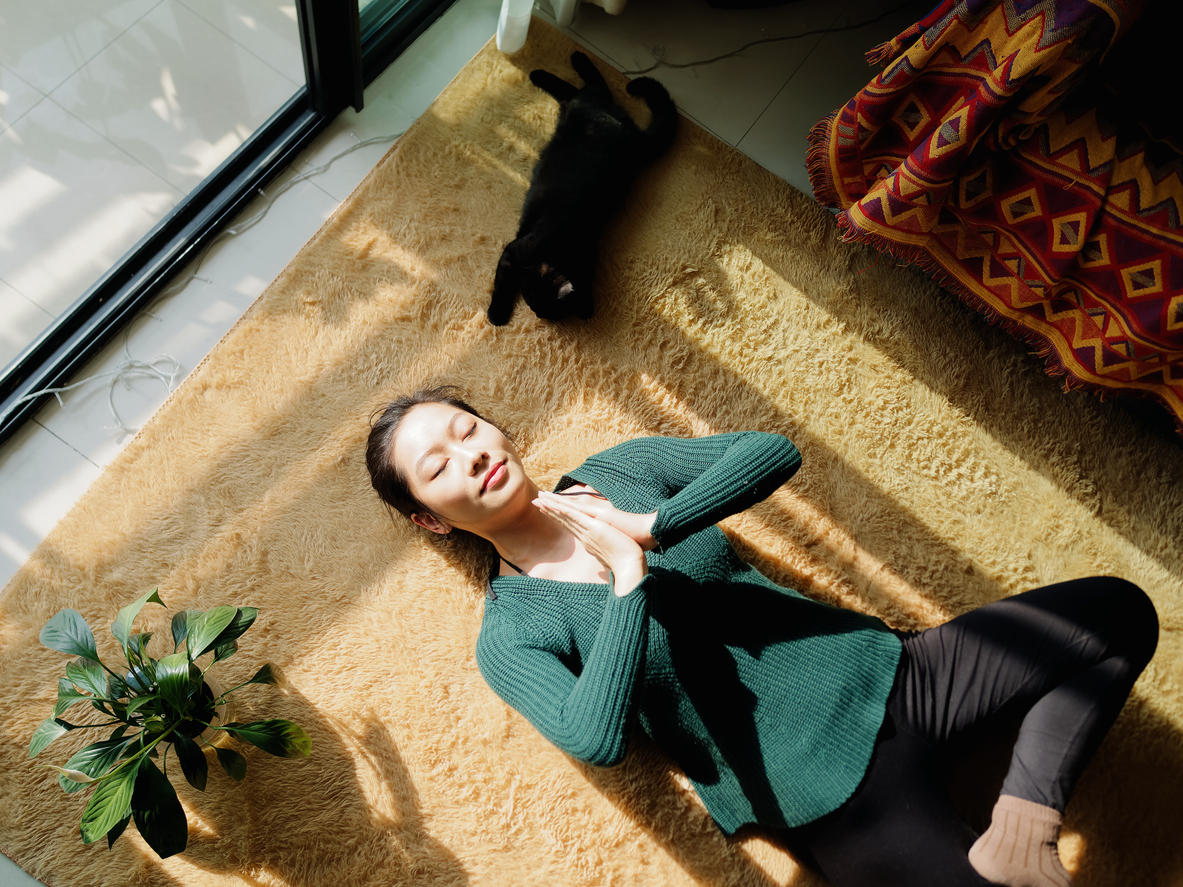
While staying at home, it can be easy to feel lazy, unmotivated to exercise, eager to eat more than usual or even overwhelmed and stressed about current events. In addition to stress, the weather is cold which lures you into your warm bed, often unwilling to physically challenge yourself in your practice. What if I told you that you can incorporate a slow-paced, restorative at home yoga sequence into your daily routine which will leave you relaxed and refreshed instead of sore and tired?
At Home Yoga Sequence
Restorative yoga sequences usually consist of only a few asanas that are held for a minimum of 5 minutes in order to supply the full benefits of each asana. The following sequence provides a wonderful way to wind down during stressful times and treat your body without feeling exhausted.
1. Child’s Pose

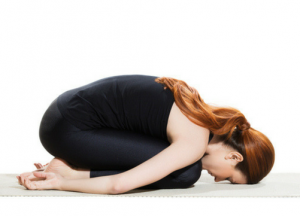 Begin in Child’s Pose, sitting back on your heels with your knees spread apart. Extend your arms in front of you and allow your forehead to rest on the mat. Take a deep inhale and with every exhale, stretch your fingertips even further and let your hips sink down toward the mat. This asana is ideal to practice at the beginning and end of a restorative sequence as it provides a gentle stretch in the lower body while relaxing the upper body and releasing tension. After a few minutes of holding this asana, feel free to try variations. For instance, you can stretch your arms to either side or thread one arm under your torso toward the other side with the other arm extended forward for a deep shoulder stretch.
Begin in Child’s Pose, sitting back on your heels with your knees spread apart. Extend your arms in front of you and allow your forehead to rest on the mat. Take a deep inhale and with every exhale, stretch your fingertips even further and let your hips sink down toward the mat. This asana is ideal to practice at the beginning and end of a restorative sequence as it provides a gentle stretch in the lower body while relaxing the upper body and releasing tension. After a few minutes of holding this asana, feel free to try variations. For instance, you can stretch your arms to either side or thread one arm under your torso toward the other side with the other arm extended forward for a deep shoulder stretch.
2. Happy Baby Pose
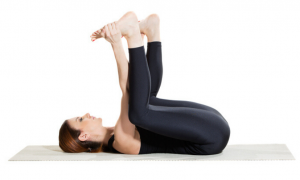 After you’ve relaxed in Child’s Pose for several minutes, slowly transition to Happy Baby Pose. To do this, walk your fingers toward your torso as you lift your upper body from the mat. Then, untuck your feet from beneath your sit bones and lie flat on your back with your knees bent. Bring your knees into your chest and grip the outsides of your feet or your big tones with your hands. Gently pull your feet outwards so that your knees open wide and you feel a deep stretch in your hips. You can choose to rock side to side for an even deeper release in the groin area or simply find stillness in this asana for a few minutes. With every exhale, allow your knees to drop closer towards the mat and focus on letting go of stress and tensions as you continue to breathe through this deep stretch.
After you’ve relaxed in Child’s Pose for several minutes, slowly transition to Happy Baby Pose. To do this, walk your fingers toward your torso as you lift your upper body from the mat. Then, untuck your feet from beneath your sit bones and lie flat on your back with your knees bent. Bring your knees into your chest and grip the outsides of your feet or your big tones with your hands. Gently pull your feet outwards so that your knees open wide and you feel a deep stretch in your hips. You can choose to rock side to side for an even deeper release in the groin area or simply find stillness in this asana for a few minutes. With every exhale, allow your knees to drop closer towards the mat and focus on letting go of stress and tensions as you continue to breathe through this deep stretch.
3. Reclining Bound Angle Pose
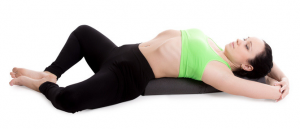 From the previous asana, release your legs onto the mat with your knees still bent and opened outwards to each side. Make sure to position your feet close to your pelvis Bring the soles of your feet to touch. Remain lying down and allow your arms to rest by your side or on your abdomen. Close your eyes and focus on taking deep breaths for up to 5 minutes in this classic, restorative asana. The benefits include stimulation of the abdominal organs, circulation, and heart as well as a gentle stretch of the thighs and knees.
From the previous asana, release your legs onto the mat with your knees still bent and opened outwards to each side. Make sure to position your feet close to your pelvis Bring the soles of your feet to touch. Remain lying down and allow your arms to rest by your side or on your abdomen. Close your eyes and focus on taking deep breaths for up to 5 minutes in this classic, restorative asana. The benefits include stimulation of the abdominal organs, circulation, and heart as well as a gentle stretch of the thighs and knees.
4. Legs-Up-the-Wall Pose
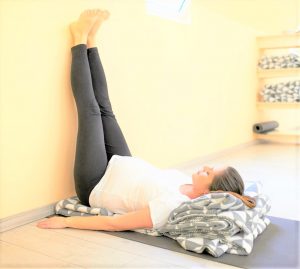 Transitioning from Reclining Bound Angle Pose, position yourself close to a wall and facing the wall, extend your legs up against it. Your back should remain straight and horizontal with your arms resting wherever they are comfortable. In this asana, your sit bones should be either touching the wall or close to it while supporting your legs and your body should be creating a 90 degree angle. Remain in this position for at least 5 minutes as you continue to breathe deeply and steadily. The benefits of this asana include increased circulation, a deep stretch in the lower back and hamstrings, stress relief, and relaxation of the pelvic floor. To exit this pose, slowly bend your knees and shift them to one side as you come to a seated position.
Transitioning from Reclining Bound Angle Pose, position yourself close to a wall and facing the wall, extend your legs up against it. Your back should remain straight and horizontal with your arms resting wherever they are comfortable. In this asana, your sit bones should be either touching the wall or close to it while supporting your legs and your body should be creating a 90 degree angle. Remain in this position for at least 5 minutes as you continue to breathe deeply and steadily. The benefits of this asana include increased circulation, a deep stretch in the lower back and hamstrings, stress relief, and relaxation of the pelvic floor. To exit this pose, slowly bend your knees and shift them to one side as you come to a seated position.
Step 5. Seated Forward Fold

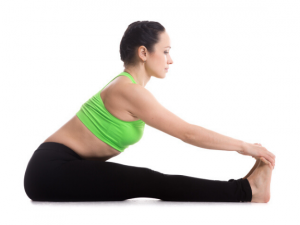 Begin by sitting on the mat with a straight back and your legs extended in front of you. Feel free to sit on a folded blanket or a bolster for additional support. As you inhale, reach your arms up towards the sky and with a deep exhale, fold your body from your hips as you attempt to reach your knees, feet, or even toes. A key thing to remember is that the goal is not to force your fingertips to your toes; instead, focus on bringing your chest to your thighs, nose to your knees, and forehead to your legs during this stretch. With every exhale, allow tension to be released from your body and surrender even further in this asana. Some benefits of Seated Forward Fold include stress relief, a deep stretch in the shoulders and spine, and improve digestion.
Begin by sitting on the mat with a straight back and your legs extended in front of you. Feel free to sit on a folded blanket or a bolster for additional support. As you inhale, reach your arms up towards the sky and with a deep exhale, fold your body from your hips as you attempt to reach your knees, feet, or even toes. A key thing to remember is that the goal is not to force your fingertips to your toes; instead, focus on bringing your chest to your thighs, nose to your knees, and forehead to your legs during this stretch. With every exhale, allow tension to be released from your body and surrender even further in this asana. Some benefits of Seated Forward Fold include stress relief, a deep stretch in the shoulders and spine, and improve digestion.
Step 6. Corpse or Savasana Pose
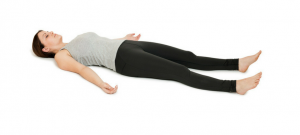 Let’s end this sequence with a mindful asana to eliminate any meaningless thoughts and ground yourself. Keep your legs extended in front of you on the mat with your arms resting by your sides with your palms facing up. Make sure that your back is straight and there is no arch in your lower back as you lie flat on the mat. Close your eyes and feel your body sink as it becomes heavier with every breath. Corpse Pose is a favorite asana for many people due to its restorative nature. Corpse Pose is a pose of total relaxation which requires remaining in a neutral position, often a challenging task. The purpose of corpse pose is to consciously calm the mind which in turn, calms the nervous system and lowers blood pressure resulting in a state of ultimate serenity. The duration of this asana depends on your preference, however 10-20 minutes are recommended.
Let’s end this sequence with a mindful asana to eliminate any meaningless thoughts and ground yourself. Keep your legs extended in front of you on the mat with your arms resting by your sides with your palms facing up. Make sure that your back is straight and there is no arch in your lower back as you lie flat on the mat. Close your eyes and feel your body sink as it becomes heavier with every breath. Corpse Pose is a favorite asana for many people due to its restorative nature. Corpse Pose is a pose of total relaxation which requires remaining in a neutral position, often a challenging task. The purpose of corpse pose is to consciously calm the mind which in turn, calms the nervous system and lowers blood pressure resulting in a state of ultimate serenity. The duration of this asana depends on your preference, however 10-20 minutes are recommended.
Reach Out To YogaRenew For More Sequences
Don’t let the stress or being at home hinder your yoga practice and instead, let it nourish it! There’s nothing wrong with leaving hatha and ashtanga yoga aside during this time and focusing on restorative poses to feel relaxed, rejuvenated, and at peace. For more info on becoming a yoga teacher contact YogaRenew.


